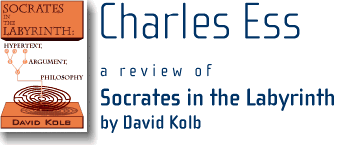Charles Ess is Chair of the Department of Philosophy and Religion, Drury University. Professor Ess is editor of Philosophical Perspectives on Computer-Mediated Communication,
It is hard to overstate the significance of Kolb's hypertext. To my knowledge, it is a pioneering work in several ways. To begin with, in my experience, most work in the medium of hypertext, and most reflection about hypertext, is defined within the disciplinary frameworks of literary theory, communication theory, etc. Philosophical reflection about hypertext, let alone philosophical use of hypertextual media, is relatively rare.
Kolb's work...skillfully exploits the various rhetorical maneuvers made possible by hypertext |
Simply considered as an essay, Kolb's piece is among the very few genuinely insightful, genuinely philosophical treatments of hypertext and its implications for nothing less fundamental than the very structures of thought and argument. More remarkably, as Kolb exploits and integrates the hypertextual medium in the development and exposition of his essay, the work stands as a striking new model of how philosophers might creatively use hypertexts to reflect and present argument in genuinely new ways. The piece itself thereby stands as one of the very few examples of hypertext I have seen which in fact manage to fulfill the hopes of hypertext enthusiasts who see in this new medium new possibilities for thought and reflection.
In particular, Kolb is one of the very few philosophers whose own work on postmodernism makes him eminently well-qualified to consider the various postmodern views which tend to drive hypertext theory. His critique of the postmodern-hypertext conjunction cannot be dismissed as reactionary rejection of new technologies and their potentials. Rather, Kolb's work offers a careful and cogent corrective to some of the more unbridled enthusiasms of hypertext proponents. The result is a more nuanced understanding of how hypertexts may both revolutionize philosophical thought (and thus all forms of thought) and make possible an equally significant recovery and development of some traditional modes of philosophical reflection and argument. In my view, this more complete understanding of the relationship between hypertexts and tradition only promises to better serve the further development of hypertext.
This is not to say that the piece is flawless. While there is a great deal of insight to be gleaned in working through the piece, and while Kolb uses the hypertextual medium in helpful and creative ways -- the medium also frustrates the reader at points. Kolb himself points out some of the limitations of hypertext with examples instantiated by the very hypertext he has created. Moreover, Kolb has been careful to label his various links, as a navigational aid to the reader. But he thereby encounters one of the frustrating limits of Storyspace. Storyspace enjoys a justified claim as one of the most advanced and powerful hypertextual writing tools available. One of its strengths is its ability to map hypertextual links, in part as it displays links names assigned by the author. Unfortunately, when more than one link exists between different texts, the map function simply displays all link names on top of one another, resulting in a largely meaningless jumble.
Despite these irritations, Kolb has done something quite remarkable here.
Kolb is one of the very few philosophers whose own work on postmodernism makes him eminently well-qualified to consider the various postmodern views which tend to drive hypertext theory |
About Socrates in the Labyrinth
About David Kolb

Eastgate
Fiction Nonfiction
Poetry Hypertext
Storyspace Tinderbox
HypertextNow Order

